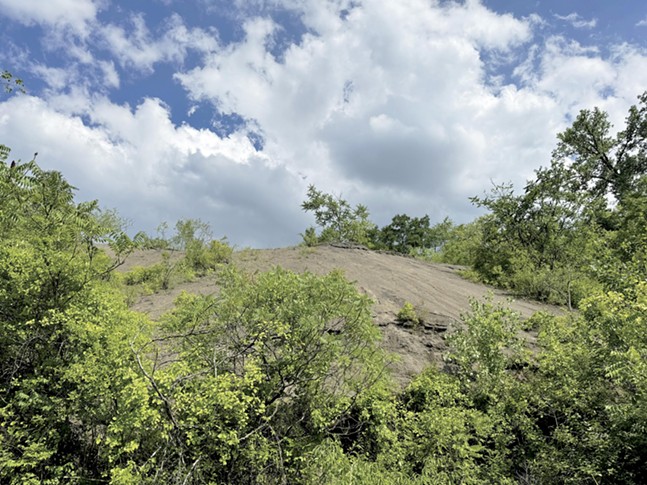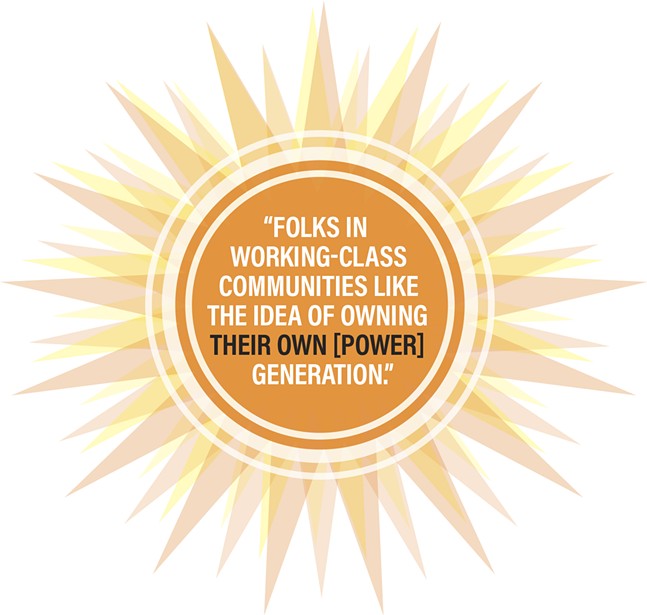The Urban Redevelopment Authority of Pittsburgh (URA) is giving a slag heap in Swisshelm Park a solar makeover.
With help from a recently received federal grant, the URA is undertaking a 70-acre land remediation and 15-acre solar development project that’ll turn one of Pittsburgh’s many brownfields into a so-called brightfield.
“A brightfield is a brownfield that has gone to solar,” says Lilly Freedman, manager of development projects at the URA. “I just think Pittsburgh, as well as other cities in upper Appalachia and the former Rust Belt, are kind of uniquely situated to really explore these brightfield opportunities.”
The Environmental Protection Agency estimates that 450,000 brownfields exist across the United States, with around 1,300 in Pennsylvania and just under 300 in Allegheny County.
After 20-plus years of clean up, the Pennsylvania Department of Environmental Protection touts the rehabilitation of 6,000 brownfields locally, including Bakery Square, SouthSide Works and other local sites.
The abundance of brownfields gives the Commonwealth a chance to get ahead in the race to increase solar capacity. According to the Solar Energy Industries Association, Pennsylvania ranks 21st for total installed solar capacity at last count in this year’s first quarter, generating a mere 2,200 megawatts.
Freedman says this new vision for Swisshelm Park had been in the works since 2019. Originally, the agency was set on a housing development, but cost was a major factor in its pivot.
“Any brownfield remediation is going to be costly, but brownfield to solar is going to be less costly than other types of development,” Freedman tells Pittsburgh City Paper.
Land remediation alone will cost approximately $6.5 million, with $2 million originating from the EPA’s Brownfield Cleanup Grant, $4 million from the American Rescue Plan Act funding and local tax increment financing helping with the rest. Redevelopment costs remain unknown as the agency prepares to solicit bids from solar developers.
Installations like the planned Swisshelm Park solar farm, while a step toward decarbonization, can only make a miniscule impact on the grid, by law. Pennsylvania limits the amount of solar energy that can be generated, but there’s a bill making its way through the Pa. House of Representatives that would unleash even more solar growth throughout the state.
The Community Solar Act, introduced by Rep. Peter Schweyer (D) and passed by the House in March, would allow for community solar organizations and administrators to develop, build, own, or operate community solar facilities. Community solar programs would also be able to provide access to the benefits of Pennsylvania community solar energy generation, regardless of the physical attributes of their home or business, including roof space, shading or ownership status.
“I represent a lot of blue collar and working-class families. Folks in those communities, no matter where in the commonwealth, they like the idea of owning their own [power] generation,” Schweyer tells City Paper.
And that’s what this bill aims to accomplish. It opens up the possibility of solar energy to people across the state, no matter where they live or whether they own a home.
“There are a whole lot of people who can't do it because of their circumstances, and that’s not fair,” Schweyer says. “That’s where community solar comes in.”
As current restrictions stand, third parties can only opt into a net-metered system, or system that rewards people with a credit on their electric bill for the energy their panels generated, if not directed to a single source.
While this sounds like it helps incentivize solar, the limits on the amount of megawatts that individuals can generate makes any energy decarbonization limited, and ultimately stagnates the state’s overall solar growth, especially in urban landscapes.
Companies will be able to compete for a long-term lease with the URA until the final quarter of this year and is open to bidders from across state lines. Construction for the solar farm will break ground in June 2026.
“If you look at the slag heaps, nature has come back on its own. And then what happens when people start using it?” says Ron Baraff, the director of historical resources and facilities at Rivers of Steel. “They create mountain biking trails, hiking trails and start making use of it. So really, this is an opportunity for the city to really embrace that and to build upon that.”
And the city is embracing its industrial history with greener prospects. The URA has undertaken many brownfield remediation projects, especially when steelmaking plummeted in the 1980s and ’90s.
While the URA has tackled projects like SouthSide Works and Hazelwood Green, this project marks a new era of redevelopment and remediation. The URA just held a community meeting about the solar project at the Swisshelm Park Community Center.
“It's just a really important thing for this region to be focusing on, in terms of the future of land reuse and recycling,” Freedman says. “We are hopeful that this will really be on the forefront of what could be lots more solar development in the City of Pittsburgh.”



